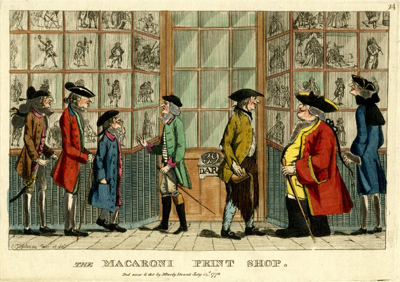Welcome to James Gillray: Caricaturist
A Start in Caricature*
By 1775, the 19 year old Gillray appears to have been back in London and to have formed some sort of association with the Humphreys, a family of printer/publishers who were to remain friends and employers for the rest of his life. M. Dorothy George and Draper Hill both identify what they believe are early Gillray prints published by William Humphrey in 1775 through 1777.
Caricature had arrived in England as early as the 1730s when artists and aristocrats returned from the Grand Tour with portrait caricatures by italian artists like Pier Leone Ghezzi among their possessions, thereby arousing the ire of William Hogarth in his Characters | Caricatures print of 1743.
It achieved further notoriety in 1756-57, when it was used by George Townshend in a series of portrait caricature cards and devastating political prints, the first time that caricature and political satire had been combined.

The Macaroni Print Shop [1772]
© Trustees of the British Museum
But it received its biggest boost in the 1770s when the latest group of Grand Tourists from Italy returned with both a passion for caricature and for the outrageous fashions of the continent. Calling themselves "macaronis," they proceeded to create or commission hundreds of prints that filled the printshops with caricatures. Most of these "macaroni prints" were done in the Italian manner—full length profiles with minimal context or background. Though generally crude in execution (and often as not created by amateurs), their popularity both publicized and legitimized the appearance of caricature portraits of real individuals, and paved the way for the use of personal portraits in the graphic satire to come.
At the same time, as caricature became more common and more accepted, its techniques of exaggerated form and feature combined with an economy of line began to be used by artists like Henry William Bunbury and later by Thomas Rowlandson to create a form of comic caricature which focused not upon specific individuals but upon the foibles and pratfalls of a variety of social types.

© Trustees of the British Museum
Here, then, was a brand new field, increasingly popular, and seemingly open to anyone with artistic ability. It is not surprising that Gillray would have been tempted to try his hand at it. Nor is it suprising that Gillray's first efforts are mainly social rather than political in nature. Of 53 prints created from 1775 through 1781, only 18 can be considered political. The son of a former soldier, now a church sexton, Gillray had no natural access to the corridors of power, nor any reliable insight into the workings of parliament. It would have been easier and no doubt closer to his own experience, to create a young man's print like Squire Thomas Just Arrived [1778] than something overtly political.
Like any new person in a new field, Gillray found his way slowly, exploring this and that, improving his skills as an artist and print-maker, adopting or developing new presentational techniques, and ultimately discovering his own individual style. But as one can easily see in Squire Thomas Just Arrived, John Hamilton Mortimer was the first and most potent influence on Gillray's early prints. A comparison between Mortimer's Iphigenia's Late Procession from Kingston to Bristol (1776) and Gillray's Grace Before Meat (1778), for instance, shows Gillray imitating Mortimer's thin and delicate line as well as his shading and cross hatching, but still unable to match the older artist in the fullness and gesture of the figures.
* The Gillray-specific information in this brief overview of Gillray's life is derived from Draper Hill's wonderful biography, Mr. Gillray The Caricaturist, and M. Dorothy George's Catalogue of Prints and Drawings in the British Museum: Political and Personal Satires. Other acknowledgements appear on subsidiary pages.